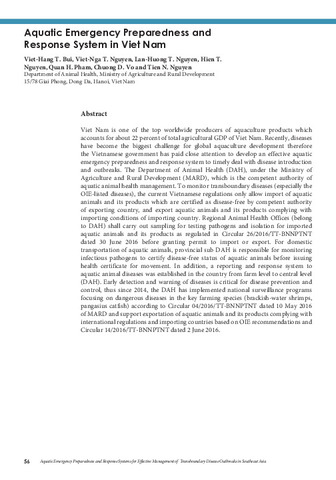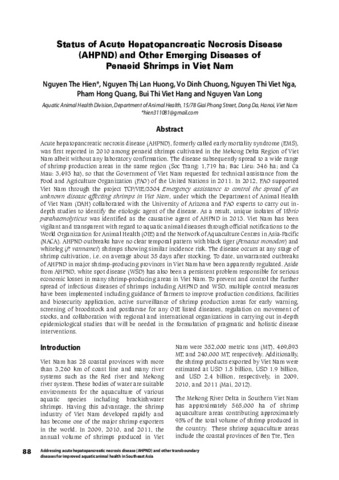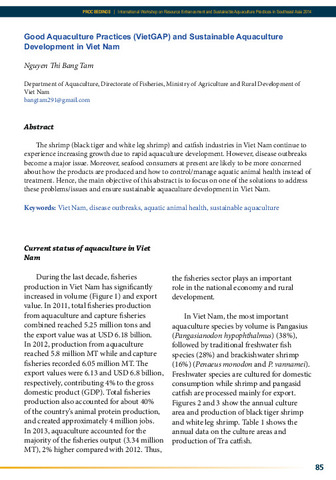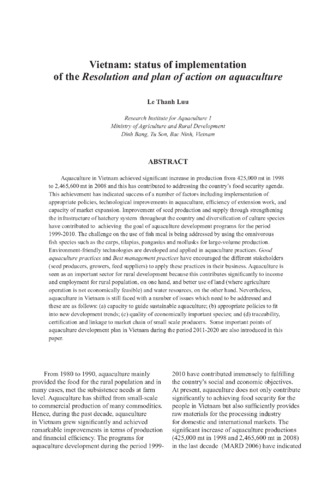Aquatic emergency preparedness and response system in Viet Nam
Share
Abstract
Viet Nam is one of the top worldwide producers of aquaculture products which accounts for about 22 percent of total agricultural GDP of Viet Nam. Recently, diseases have become the biggest challenge for global aquaculture development therefore the Vietnamese government has paid close attention to develop an effective aquatic emergency preparedness and response system to timely deal with disease introduction and outbreaks. The Department of Animal Health (DAH), under the Ministry of Agriculture and Rural Development (MARD), which is the competent authority of aquatic animal health management. To monitor transboundary diseases (especially the OIE-listed diseases), the current Vietnamese regulations only allow import of aquatic animals and its products which are certified as disease-free by competent authority of exporting country, and export aquatic animals and its products complying with importing conditions of importing country. Regional Animal Health Offices (belong to DAH) shall carry out sampling for testing pathogens and isolation for imported aquatic animals and its products as regulated in Circular 26/2016/TT-BNNPTNT dated 30 June 2016 before granting permit to import or export. For domestic transportation of aquatic animals, provincial sub DAH is responsible for monitoring infectious pathogens to certify disease-free status of aquatic animals before issuing health certificate for movement. In addition, a reporting and response system to aquatic animal diseases was established in the country from farm level to central level (DAH). Early detection and warning of diseases is critical for disease prevention and control, thus since 2014, the DAH has implemented national surveillance programs focusing on dangerous diseases in the key farming species (brackish-water shrimps, pangasius catfish) according to Circular 04/2016/TT-BNNPTNT dated 10 May 2016 of MARD and support exportation of aquatic animals and its products complying with international regulations and importing countries based on OIE recommendations and Circular 14/2016/TT-BNNPTNT dated 2 June 2016.
Suggested Citation
Bui, V.-H. T., Nguyen, V.-N. T., Nguyen, L.-H. T., Nguyen, H. T., Pham, Q. H., Vo, C. D., & Nguyen, T. N. (2019). Aquatic emergency preparedness and response system in Viet Nam. In E. A. Tendencia, L. D. de la Peña, & J. M. V. de la Cruz (Eds.), Aquatic Emergency Preparedness and Response Systems for Effective Management of Transboundary Disease Outbreaks in Southeast Asia: Proceedings of Asean Regional Technical Consultation, 20-22 August 2018, Centara Grand Central Ladprao, Bangkok, Thailand (pp. 56-63). Tigbauan, Iloilo, Philippines: Aquaculture Department, Southeast Asian Fisheries Development Center.
Subject
disease control  ; Disease detection; disease resistance
; Disease detection; disease resistance  ; disease transmission
; disease transmission  ; epidemiology
; epidemiology  ; husbandry diseases
; husbandry diseases  ; aquaculture regulations
; aquaculture regulations  ; quarantine regulations
; quarantine regulations  ; fish culture
; fish culture  ; fish diseases
; fish diseases  ; trade
; trade  ; standards
; standards  ; Health and safety; safety regulations
; Health and safety; safety regulations  ; aquaculture development
; aquaculture development  ; pathogens
; pathogens  ; animal diseases
; animal diseases  ; transportation
; transportation  ; aquaculture products
; aquaculture products  ; aquaculture
; aquaculture  ; rural development
; rural development  ; brackish water
; brackish water  ; detection
; detection  ; emergencies
; emergencies  ; Freshwater fish; aquatic animals
; Freshwater fish; aquatic animals  ; products
; products  ; countries
; countries 
 ; Disease detection; disease resistance
; Disease detection; disease resistance  ; disease transmission
; disease transmission  ; epidemiology
; epidemiology  ; husbandry diseases
; husbandry diseases  ; aquaculture regulations
; aquaculture regulations  ; quarantine regulations
; quarantine regulations  ; fish culture
; fish culture  ; fish diseases
; fish diseases  ; trade
; trade  ; standards
; standards  ; Health and safety; safety regulations
; Health and safety; safety regulations  ; aquaculture development
; aquaculture development  ; pathogens
; pathogens  ; animal diseases
; animal diseases  ; transportation
; transportation  ; aquaculture products
; aquaculture products  ; aquaculture
; aquaculture  ; rural development
; rural development  ; brackish water
; brackish water  ; detection
; detection  ; emergencies
; emergencies  ; Freshwater fish; aquatic animals
; Freshwater fish; aquatic animals  ; products
; products  ; countries
; countries 
Related items
Showing items related by title, author, creator and subject.
-
Status of acute hepatopancreatic necrosis disease (AHPND) and other emerging diseases of penaeid shrimps in Viet Nam
Hien, Nguyen The; Huong, Nguyen Thi Lan; Chuong, Vo Dinh; Nga, Nguyen Thi Viet; Quang, Pham Hong; Hang, Bui Thi Viet; Long, Nguyen Van (Aquaculture Department, Southeast Asian Fisheries Development Center, 2016)Acute hepatopancreatic necrosis disease (AHPND), formerly called early mortality syndrome (EMS), was first reported in 2010 among penaeid shrimps cultivated in the Mekong Delta Region of Viet Nam albeit without any laboratory ... -
Good aquaculture practices (VietGAP) and sustainable aquaculture development in Viet Nam
Nguyen, Thi Bang Tam (Aquaculture Department, Southeast Asian Fisheries Development Center, 2015)The shrimp (black tiger and white leg shrimp) and catfish industries in Viet Nam continue to experience increasing growth due to rapid aquaculture development. However, disease outbreaks become a major issue. Moreover, ... -
Vietnam: status of implementation of the resolution and plan of action on aquaculture.
Luu, Le Thanh (Aquaculture Department, Southeast Asian Fisheries Development Center, 2011)Aquaculture in Vietnam achieved significant increase in production from 425,000 mt in 1998 to 2,465,600 mt in 2008 and this has contributed to addressing the country s food security agenda. This achievement has indicated ...




